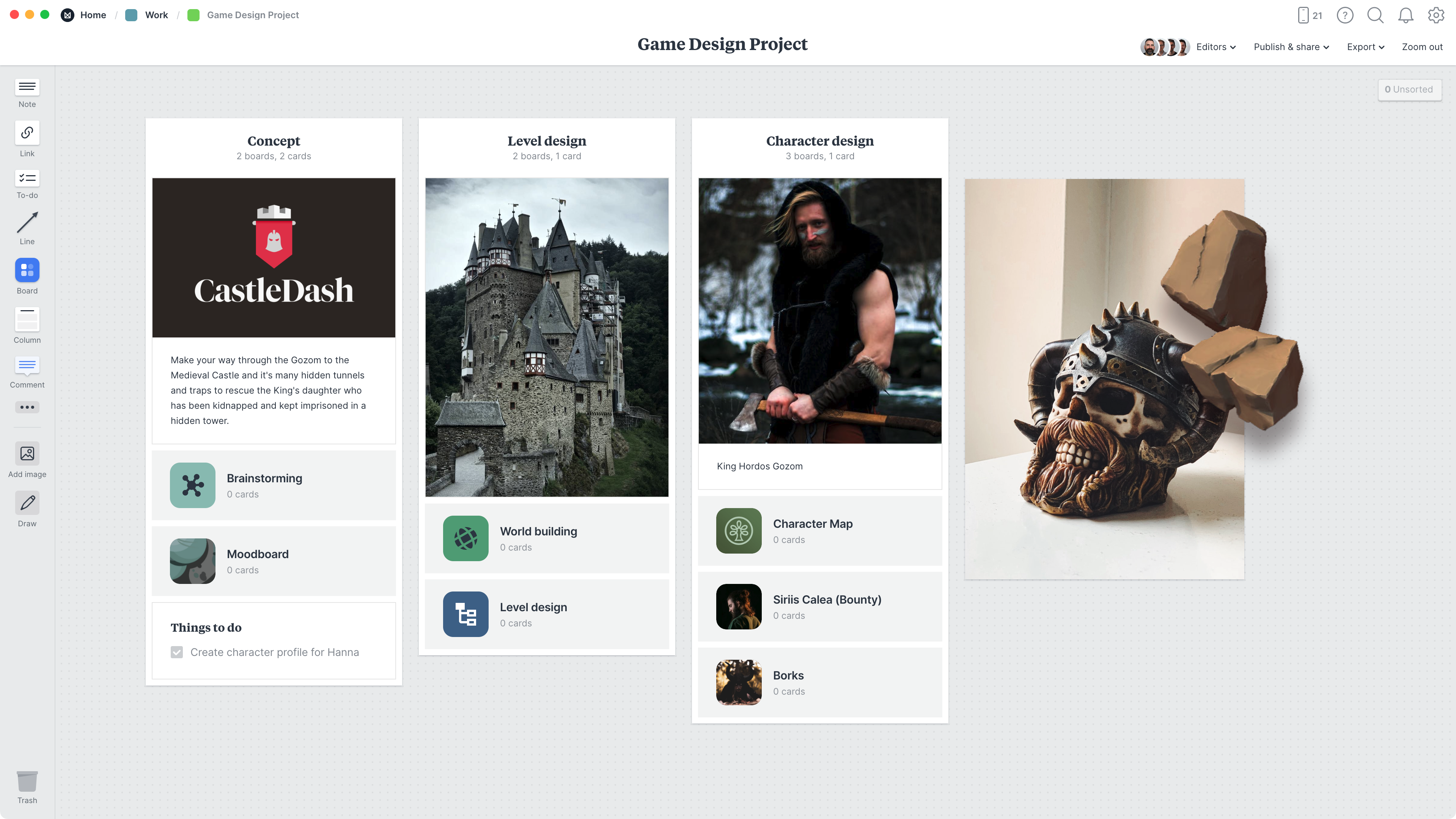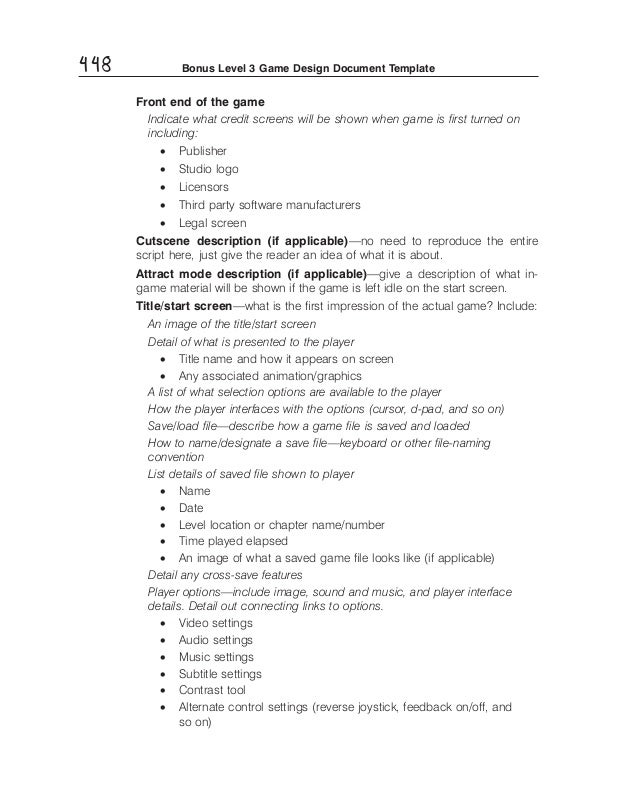Table Of Content

Remember that anyone — from artists to marketers — may refer to this when working on the game. A game design document or “GDD” is the master document which lists all of the features, concepts and ideas which are supposed to gel together to create the final game experience. Large and overly detailed game design documents generally require a lot of upfront work, are almost always out of date and can be restrictive, particularly if the design of your game is likely to change over time.
Rule #2: Start with one concise sentence
"No one reads GDDs anyway." "They become outdated the minute you finish writing them." It’s important to remember that lots of people from many different disciplines may refer to a GDD — from artists and level designers, to engineers, composers and even the marketing team. So creating a document that’s easy for everyone to understand is really important. Since there’s no exact way of formatting your GDD game design document, you still have to clarify the project’s vision and provide details on its every development stage. It is a special type of documentation that shows your team the right direction to develop games on android.

Gameplay Mechanics
Knowing how to write a game design document is a common job requirement for game designers, and for good reason. Proper design documentation can be one of the most important elements of video game production. Without them, team members may struggle to stay on the same page when designing features, and development can run horribly awry. Many studios use Game Design Documents (GDDs) to communicate their vision for a game to other team members or stakeholders. Though the days of any sort of monolithic GDD format or design bible are long gone, they still have a place in many designers' and teams' methodologies.
How to write a game design document (with examples)
A game designer's new friend: how to use ChatGPT as a gamedev tool - Game Developer
A game designer's new friend: how to use ChatGPT as a gamedev tool.
Posted: Mon, 21 Aug 2023 07:00:00 GMT [source]
You can also include any concept art you or your team may have made. Even if it’s far from being final, it will give readers an idea of the overall art direction you have in mind. Then outline the game’s objectives — both short-term goals within each level, and overarching goals that span the whole game. Be sure to discuss any progression systems, like character leveling up or unlocking new abilities. Start by describing the game’s unique selling points, and point out what might set it apart from other games in the market. Be sure to identify your target audience, because that will help guide many different design decisions.
Real-Life GDD Examples
Or, if the narrative of the game is important, this is where you might outline the basic story. When you’re making your game there’s a good chance that, at some point, you’re going to need to write down how it works. Building a fantasy or general world may be more labor-intensive on your brain, but it is your chance to really flesh out what world the characters will interact in. Delving deeper, you need to flesh out the descriptions of the story, setting, and who the characters will eventually be. Back to Grand Theft Auto V, the story revolves around three characters, Michael, Franklin, and Trevor. However, you need to be extremely specific, as this could muddy the waters with individual developers.
Technical Description
Think of the title page as the beginning of the ‘cover letter,’ but for game design. For example, a title page will include the title of the project, like ‘The Witcher.’ The title page will also include many other aspects listed below. Fueling creativity can keep morale high and lead to excellent games. It can also lead to surprise last-minute additions that end up being one of the game’s best features.

It serves as the definitive blueprint that aligns everyone’s efforts toward a singular, cohesive vision. While the core gameplay loop provides an overview of the main actions players will take, this section of the game design document template should delve deeper into the specific mechanics making them up. While a Game Design Document (GDD) is a valuable tool for most game development projects, not every game necessarily needs one. The necessity of a GDD can vary depending on the scope and complexity of the game, the size of the development team, and the development process itself. Smaller indie games or hobbyist projects might not require a formal GDD, as their teams can maintain a shared vision through informal communication.
Pitch deck template and useful tips for indie developers from SUPERHOT BizDev - Game World Observer
Pitch deck template and useful tips for indie developers from SUPERHOT BizDev.
Posted: Fri, 16 Jun 2023 07:00:00 GMT [source]
In this post, we will look closely at one of the most important cornerstones of your future release — a game design doc or a GDD. Instead, try to think of the one-page approach, and game design documents in general, as an exercise in communication. By now, you know that writing a good GDD is an important, early step in the creation of your game. It helps you think through your design, define your initial scope, and rally your team and other stakeholders around your vision. By following the steps and writing some key sections, you’ll start building a solid foundation for your game’s development. In the Story section, you’ll outline your game’s narrative, characters, and settings.
Game Design Keynotes:
If you’re working with a team, you’re going to want to enter the discussion phase next. Everyone will bring something different to the project, and getting together to talk about the project can bring out the best in your unique team. As you work through something, it’s easy to get caught up in it and forget why you’re doing it in the first place. A simple example here is to create a chart showing a menu screen, intro screen, the HUD during a level of play, and an ending screen. Mechanics can broadly be defined as the ways players interact with the world and systems of the game, and the way those systems give feedback or react to the player's actions. This should be a brief introduction to the project itself, often with a very clear vision statement outlining the high-level pitch for the game and what makes it special.
It is a collaborative effort, as it requires input and insights from various team members, including artists, programmers, writers, and producers. These tools are just a starting point for the development process, ensuring a solid foundation for the final product. Conversely, game design wikis offer a more flexible and collaborative approach to game design documentation.
Creating a game is no easy feat; planning and organization are crucial throughout all stages of development, and proper documentation of ideas within the title is essential. This is where the game design document template (also known as GDD) comes into play, and every successful game development team relies on it. It also needs to give anyone reading your GDD a quick and easy-to-understand overview of what your game is all about. A game design document, often referred to as a GDD, is a detailed internal document that covers a number of aspects of a video game’s design and development. The primary goal is to explain the core vision of the project, as well as setting the scope and laying out guidelines that the team can refer back to throughout development.
This is not the most intuitive section, but it really helps to narrow down your scope if you think about what are the skills your player needs to master in order to play your game. Believe us, writing this list will help you find problems in your Game Design. For example, you may be trying to develop a game for kids but realize you require them to do something that is too advanced for their age, or some inputs may be good for Mobile but not for a Console with a Joystick. Also, if your game is going to have Custom HW built around it, then this list will allow you to figure out what components you’ll need to make it work. 1.- Like every other industry, the game industry evolves, and the techniques that are used one day quickly become a thing of the past. Specially on a young industry that is still developing it's processes, metrics, etc....

No comments:
Post a Comment